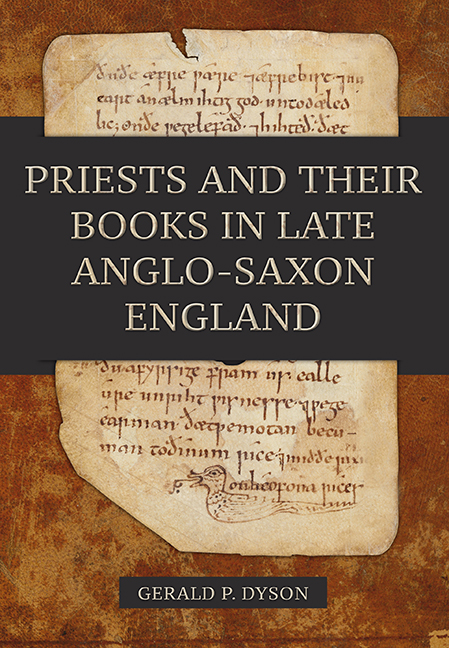Book contents
- Frontmatter
- Dedication
- Contents
- List of Illustrations
- Acknowledgements
- Introduction
- 1 Priests, Books, and Pastoral Care
- 2 “Ne cunnon þæt leden understandan”: Issues of Clerical Literacy
- 3 Demand and Supply: Production and Provision of Books for Priests
- 4 Preaching and Homiletic Books for Priests
- 5 Performing the Liturgy: Priests’ Books for the Mass and Office
- 6 Locating Penitentials, Manuals, and Computi
- Conclusions
- Appendix
- Bibliography
- Index
- Anglo-Saxon Studies
1 - Priests, Books, and Pastoral Care
Published online by Cambridge University Press: 12 June 2021
- Frontmatter
- Dedication
- Contents
- List of Illustrations
- Acknowledgements
- Introduction
- 1 Priests, Books, and Pastoral Care
- 2 “Ne cunnon þæt leden understandan”: Issues of Clerical Literacy
- 3 Demand and Supply: Production and Provision of Books for Priests
- 4 Preaching and Homiletic Books for Priests
- 5 Performing the Liturgy: Priests’ Books for the Mass and Office
- 6 Locating Penitentials, Manuals, and Computi
- Conclusions
- Appendix
- Bibliography
- Index
- Anglo-Saxon Studies
Summary
Priests were ubiquitous figures in the medieval world. The liturgical and pastoral functions they performed necessitated their presence at every level of society. Additionally, the education they received and passed on made them useful teachers, scribes, and agents of royal and diocesan administration, and various sources show priests acting as glossators, buyers and sellers of land, and, less commonly, as thieves and fornicators. Despite the wide variety of functions performed by priests, the provision of pastoral care was one of their primary functions and they served in a variety of institutions and social circumstances to fulfill this role. As this study analyzes priests’ books, understanding the context in which these books were used is vital to their interpretation. When one refers to Anglo-Saxon priestly books, one refers to the possessions and “spiritalia arma” of an extremely diverse group of individuals living and working in variable contexts. What follows is a brief discussion of the varied physical and social circumstances of priestly ministry to provide a context for the provision, use, and circulation of priests’ books for use in pastoral care. An examination of the institutions and content of pastoral care along with a consideration of the books that were required for priestly ministry will provide an understanding of the circumstances in which pastoral care took place and in turn will inform the discussion of the expectations that governed the use of priests’ books.
Settings of pastoral ministry
A well-known passage from VIII Athelred, a royal law code promulgated in 1014, serves to adumbrate the types of churches in which late Anglo-Saxon priests were working. This passage delineates the “chief minster”, a “minster of the middle class”, a smaller minster, and a field church, as well as the monetary penalties to be paid for violations of the sanctuary of each class. The “chief minster” (OE heafodmynster) is quite clearly in reference to an episcopal or archiepiscopal seat. Until the Benedictine reform of the mid-tenth century, the clerics serving in cathedral communities were almost invariably secular, as the communities of continental cathedrals were and continued to be in the tenth and eleventh centuries. Secular cathedral communities in England however underwent significant change during these centuries, some through processes of monasticization and others through the institution of rules of life for the secular clergy, though the latter trend is only evident after 1050.
- Type
- Chapter
- Information
- Priests and their Books in Late Anglo-Saxon England , pp. 17 - 42Publisher: Boydell & BrewerPrint publication year: 2019



